For content marketers looking to implement an inbound video marketing strategy/series, look towards HubSpot as a leading example. Full disclosure: I’m not a HubSpot customer nor am I on their payroll. I simply believe their inbound video marketing methodology has practical applications for organizations of any size.
Here’s the thing: the videos aren’t flashy. The setups don’t break the bank. The content is about the viewer’s needs – not the company – which is a necessary perspective for a coherent strategy.
Perfect the Basics
-
Scripted & rehearsed
-
Clear sound quality
-
Subjects lit and distinguishable
-
Visual compositions are not crowded
-
Contrast foreground & background
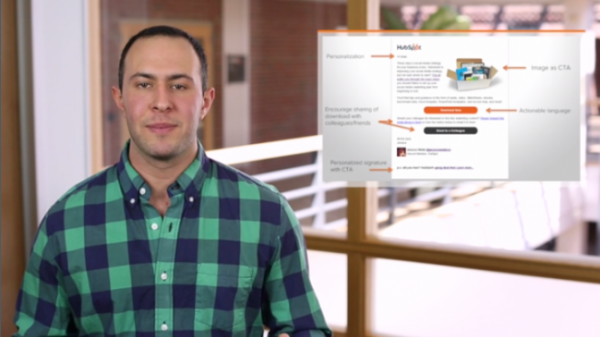
Each video reaches several fundamental checkpoints that are crucial to delivering a valuable experience. Formats are consistent, scripted, and rehearsed. The sound quality is clear. Personnel are evenly lit. Compositions allow for room in the frame for cutaways, overlays, and balance. The foreground is contrasted from the background (often by the speaker’s colorful wardrobe).
Keep It Simple
HubSpot’s visual approach favors simplicity. The camera rarely moves which reduces the coordination needed for kinetic cinematography. In addition, HubSpotters stand on designated marks which allow for easier matching and continuity in the editing process.
Props are periodically shown for levity. They are inexpensive, eye-catching, and serve to alleviate the monotony of talking heads. They’re small flashes of personality that allow presenters to put their own mark on proceedings.
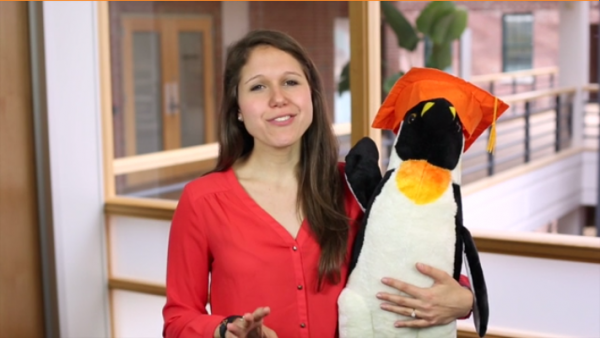
Filming occurs in an isolated location inside HubSpot’s offices. Again, careful attention is given to recording high quality audio free of noise. If viewers can’t hear what you’re saying, they will leave.
What is missing? Dizzying editing, ridiculous CGI, or uber-complex camera work. This safe approach to creating a series possesses sound wisdom for video marketers of all levels: start small, invest inward, and branch out (creatively) when your content is proven.
Make Learning (and Therefore Conversion) Easy
The aim of the inbound academy is delighting audiences through education. The academy intersects site navigation, video structuring, and a host of other features for a richer and more comprehensive learning experience.
Videos are categorized under thematic chapters. Each chapter contains a series that can stand alone and act as threads in a greater tapestry. Here, audiences have the ability to jump around materials though linear progression is recommended. Viewers have the option to increase or decrease playback speeds, pause play, and re-watch as many times as desired.
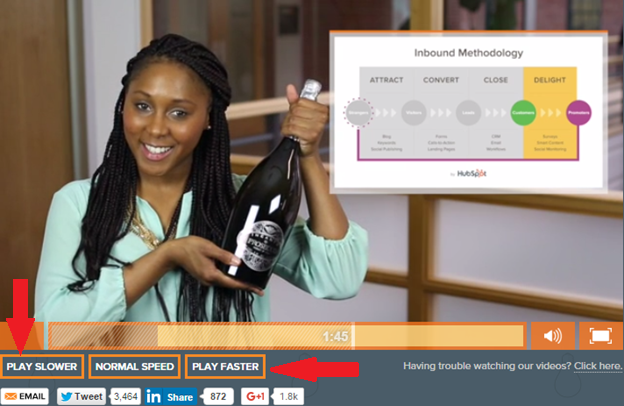
Graphics are presented in a tasteful manner that underlines key points, tips, and ideas. Rather than competing with presenters, these inserts and cutaways are valuable visual aides to complement what’s spoken.
However, a video (or even the series) isn’t enough. HubSpot adds value with supplementary content offers like slides, transcripts, ebooks, blog posts, help forums, and self-quizzes for reinforcement.
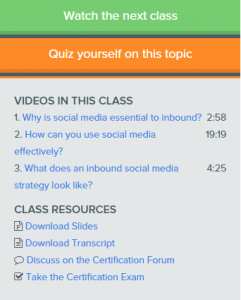
More importantly, additional value offerings provide support for viewers and direct consumption behaviors based on actionable next steps. Here, A/B testing and data analysis reveals what paths audiences take when interacting with “next level” content beyond each video. This information influences optimization strategies as HubSpot implements better and better offers that set expectations and move viewers closer to conversion.
Remove Distractions
Obstacles to learning create dissatisfaction and your organization suffers the consequences. Ask yourself: what’s necessary for people to thrive when watching my videos? What can be removed, kept, or added to enrich the experience?
Inbound academy videos are hosted through Wistia, a leading video hosting and video marketing platform. What’s the benefit of ditching YouTube in favor of a third-party provider you ask? (Full disclosure: we’re not Wistia customers nor are we paid to write this. We just admire them…alot.)
You control the flow of content consumption with a third-party solution. Viewers stay on your site when they watch. For starters, you don’t own YouTube’s digital real estate. It’s not your space nor your agenda. You might compete with other distractions like pre-roll or instream ads that have nothing to do with your offer/industry/brand. Subsequent suggested videos may feature your competitors and direct eyeballs away from your value proposition and disrupt conversion.
The navigation and site structure is designed to offer supplemental and complementary content resources. If viewers find this layout too cluttered or overwhelming, they have the option of full-screen playback to focus solely on the video.
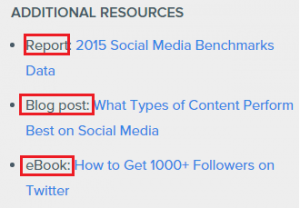
Don’t Be Afraid of Long(er) Videos
Each section begins with a 3-4 minute introduction. Here, speakers convey the importance of each component to inbound marketing and onboard viewers to the module. Much of the first sequence rationalizes the why behind each category is fundamental to inbound marketing. The second entry largely the covers the how, when, where, and what best practices that are applicable. The final portion highlights real world examples of various companies putting those concepts into action and their results.
HubSpot subscribes to the belief that audiences are willing to invest time in a video if they believe a worthwhile amount of value is attainable. Previous years of the IMC course followed a similar chapter structure with 4-5 videos running approximately 4-7 minutes each. Now, each category contains a beginning, middle, and end that resembles a three act structure. While total footage time may not have changed significantly, there’s a definite reduction in the actual number of videos a student must watch.
Consider producing longer videos for the middle and bottom of your conversion cycles. These are golden opportunities to articulate your expertise and value propositions through longer-form inbound video marketing items like case studies, testimonials, or product demos. Even if these capabilities are currently beyond your means, focus on where your buyers are in their journey and create video content that addresses their problems.

Pingback: Our New Year's Video Marketing Resolutions for 2016